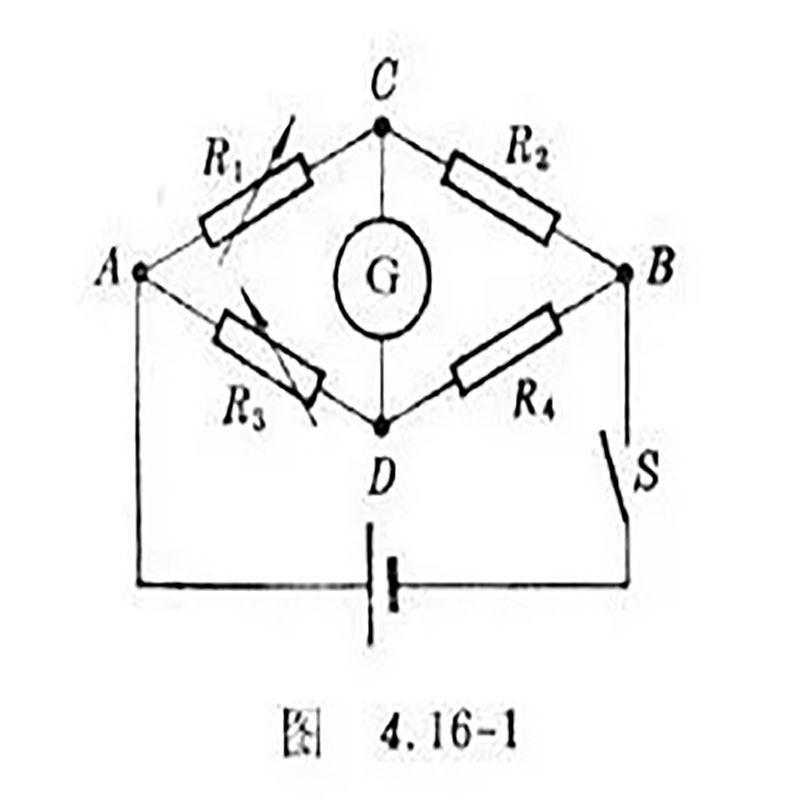An instrument for measuring various quantities (such as resistance, capacitance, inductance, etc.) by comparison. The simple circuit is composed of four branches, each branch is called the "arm" of the bridge. As shown in the figure, there is an unknown resistance (R2), one diagonal is connected with DC power supply u, and the other diagonal is connected with galvanometer G. If there is no current passing through G, the bridge will be balanced, and the unknown resistance R2 = R1 · R4 / R3.

Brief introduction to the principle of electric bridge
As shown in the figure, suppose four resistors are fixed. When s is closed, if "R3 * R2 = R1 * R4" is satisfied, that is, the resistance product of the diagonal is equal, then UCD is equal to 0, that is, there is no voltage between CDs. Using this principle, when one of the four quantities on both sides of the equation is an unknown quantity, if the equation can be established by adjusting the other three values, then the unknown quantity can be obtained by using the formula.
But in fact, as long as there is an adjustable variable resistor on each side of the equation, then one of the other two resistors is a fixed value, then the remaining one must be obtained. This principle can be used to make resistance measurement box, and this principle uses the concept of "bridge", or "balanced bridge".
Function of electric bridge
The bridge is divided into single arm bridge and double arm bridge. It is mainly used to measure the DC resistance of all kinds of equipment with inductive characteristics, especially for the measurement of DC resistance of large power transformers and mutual inductors. The measurement is simple, fast and easy to operate. It is a resistance measurement tool.
Use of electric bridge
Bridge circuit is a basic way of circuit connection in electromagnetic measurement. Because of its accurate measurement, ingenious method and convenient use, it has been widely used. Bridge circuit can use not only DC power, but also AC power, so it can be divided into DC bridge and AC bridge.
DC bridge is mainly used for resistance measurement, it has two kinds of single bridge and double bridge. The former is often called Wheatstone bridge, which is used for 1 ~ 10 ^ 5 Ω Measurement of the median resistance of the range; The latter is often called Kelvin bridge, which is used for 10 ^ (- 6) ~ 10 ^ 2 Ω Low value resistance measurement of the range.
Basic characteristics of measuring bridge
The output of the bridge will not be affected if the resistance of adjacent bridge arms changes in the same size and sign, or vice versa.
If the resistance of adjacent bridge arms changes in the same size and opposite sign, or the resistance of relative bridge arms changes in the same size and same sign, the output of the bridge will be doubled, that is, the sensitivity of the bridge will be doubled.
If the resistance of adjacent bridge arms changes in the same magnitude and opposite sign, while the resistance of relative bridge arms changes in the same magnitude and same sign, the output of the bridge will increase by three times, that is, the sensitivity of the bridge will increase by four times.
How to use electric bridge
Six R20 dry cells and three 6f22 dry cells are installed in the battery box on the back of the bridge according to the polarity. When the working power supply of the bridge is externally connected, the built-in R20 battery should be taken out completely;
The zero switch power switch will be transferred to the "Tong" position. After 5 minutes, the "zero adjustment" knob will be adjusted to make the pointer point to "0". Rotate the magnification plate and measuring plate back and forth several times to make the switch and sliding plate contact well;
Connect the measured resistance to C1, P1, P2 and C2 terminals of the bridge by pressing the four terminal button method, where AB is the measured resistance. Measurement 0.1 Ω When the resistance is below, the resistance of connecting wire for measurement shall not be greater than 0.01 Ω; Estimate the value of the resistance to be measured, select the magnification plate and the measuring plate properly, press the "g" and "B" buttons, and adjust the measuring plate at the same time to make the zero indicator point to zero again. At this time, the bridge is balanced, and the resistance to be measured Rx is the indication value of Rx = magnification * measuring plate;
The sensitivity of the zero indicator should be placed at a lower position at the beginning, and then increased after the bridge is initially balanced, so as to shorten the measurement time and prevent the damage of the pointer of the zero indicator.
Matters needing attention in bridge operation procedures
Measurement 0.1 Ω The "B" button should be used intermittently when the resistance is below to save electricity. When measuring the DC resistance of charged inductor, press "B" first and then "g"; When disconnecting, put "g" first and then "B";
After the bridge is used, reset the "B" and "g" buttons and turn off the "BG" switch. If the bridge is not used for a long time, all batteries should be removed.
The storage environment of the bridge: temperature 5 ~ 35 ℃, relative humidity 25% ~ 80%, no corrosive gas in the air, avoid direct sunlight.






